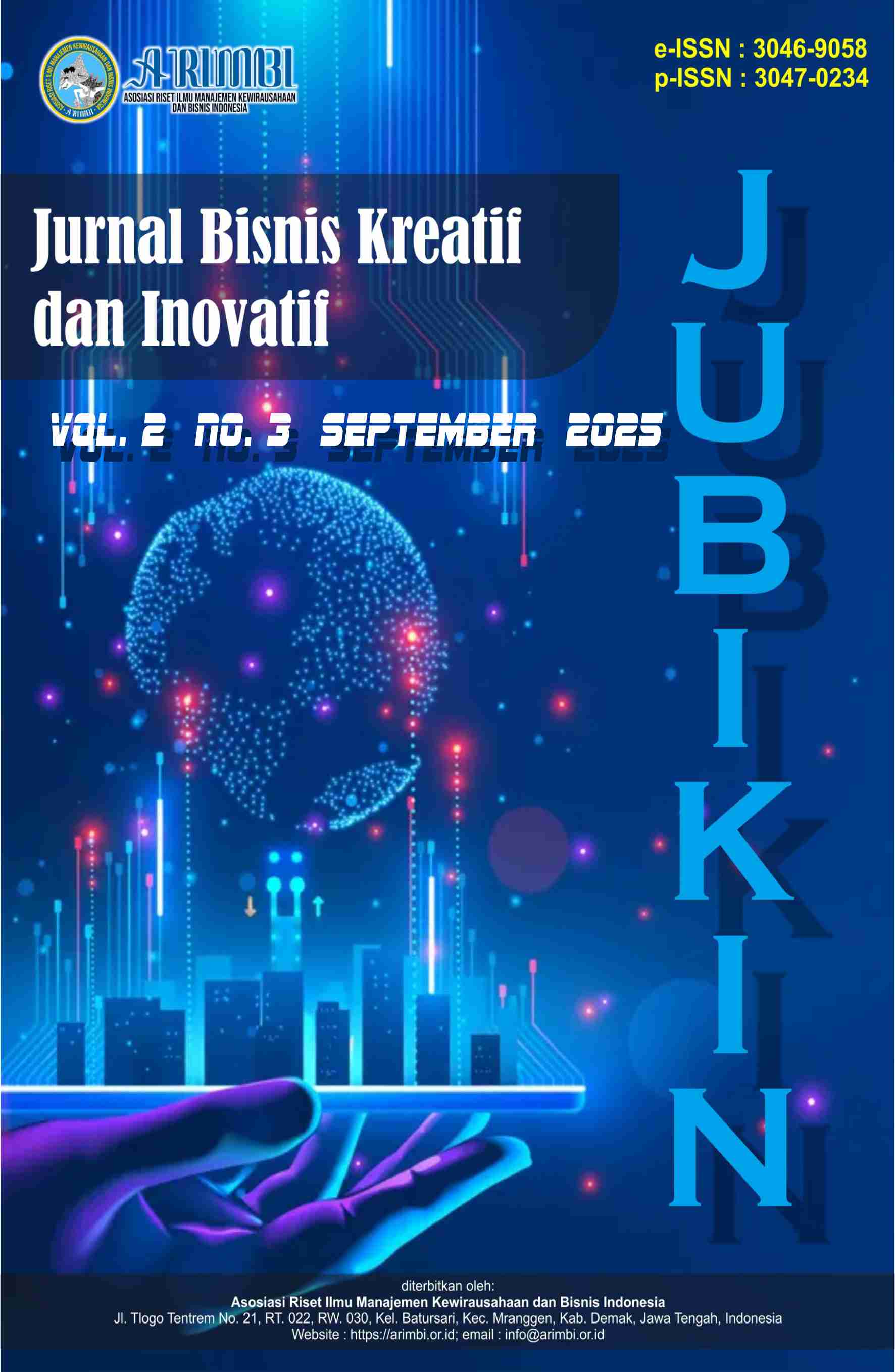Pengaruh Persepsi Kemudahan, Keamanan, dan Pengaruh Sosial terhadap Minat Penggunaan QRIS sebagai Metode Pembayaran di Bandar Lampung
DOI:
https://doi.org/10.61132/jubikin.v2i3.853Keywords:
Easy, Interest, QRIS, Secure, SocialAbstract
The study try to explain the influence of perceived ease of use, perceived security, and social influence on consumer interest in adopting the QRIS as a digital payment method in Bandar Lampung. The rapid growth of digital transactions and the shift toward non-cash payments highlight the importance of understanding the factors that encourage consumer adoption of QRIS. A quantitative approach was employed, collecting primary data from 222 respondents through structured questionnaires distributed in various retail and public settings. The data were measured with Pearson correlation, and simple linear regression to measure the strength and significance of the variable’s relationships. The findings indicate that all three factors significantly influence consumer interest, with social influence showing the strongest effect, followed by perceived security and perceived ease of use. The results suggest that social norms, trust in transaction security, and ease of interaction with the system are critical in motivating consumers to adopt QRIS. These insights provide practical implications for service providers, policymakers, and merchants to enhance digital payment adoption by focusing on user-friendly designs, robust security measures, and strategies that leverage social influence to encourage broader usage.
Downloads
References
Alifia, Permana, & Harnovinsah. (2024). Penggunaan QRIS pada Peningkatan Pendapatan UMKM. Riset Ekonomi, 9(1), 102–115.
Aprianti, Sari, & Pratama. (2023). Pengaruh keamanan terhadap minat QRIS. Eko Digital, 8(1), 45–56.
Bank Indonesia. (2019). Implementasi QRIS nasional. Siaran Pers.
Baron, & Byrne. (2005). Social psychology. Pearson.
Bodhi, & Tan. (2022). Keamanan Sistem Pembayaran E-Wallet akan Ancaman Tipuan. UNES, 4(3), 297–308. https://doi.org/10.31933/unesrev.v4i3.236
Davis. (1989). Perceived Usefulness User Acceptance of Information Tech. MIS, 13(3), 319. https://doi.org/10.2307/249008
Demir, Pesqué-Cela, Altunbas, & Murinde. (2020). FinTech and income inequality. European Finance, 26(4–5), 1–19.
Desvronita. (2021). Sikap pengguna dan adopsi QRIS. Bisnis, 7(2), 88–97.
Fadhilah, Rahman, & Putri. (2021). Kemudahan penggunaan dan minat konsumen pembayaran digital. Sistem Informasi, 13(3), 211–220.
Fajar, & Larasati. (2021). Peran Fintech dalam Perkembangan UMKM. Humanis, 1(2), 702–715.
Fiorentina. (2023). Determinan keputusan pelaku UMKM menggunakan QRIS. Kewirausahaan, 11(1), 33–42.
Hair, Babin, & Black. (2014). Multivariate Data. Cengage.
Hair, Black, Babin, & Anderson. (2010). Multivariate Data. Pearson.
Joan, & Sitinjak. (2019). Pengaruh persepsi kemudahan terhadap niat penggunaan fintech. Sistem Informasi, 15(2), 112–120.
Kamil. (2020). Keamanan sistem informasi. Teknologi Nusantara.
Kotler, & Keller. (2016). Marketing Management. Pearson.
Mishra, Pandey, & Singh. (2019). Descriptive statistics. Anaesthesia, 22(1), 67. https://doi.org/10.4103/aca.ACA_157_18
Muchtar, Trianto, Maulana, Alim, Marasabessy, Hidayat, Junaedi, & Masrizal. (2024). QRIS E-payment adoption. Cogent, 11(1). https://doi.org/10.1080/23311975.2024.2316044
Nasya. (2023). Persepsi kemudahan dan minat keuangan digital. Bisnis Digital, 5(2), 101–110.
Nugraha, Pratama, & Sari. (2021). Technology Acceptance Model. Manajemen Dan Teknologi Informasi, 7(1), 45–56.
Nurhidayati. (2023). Peran Quick Response Code Indonesian Standard.
Pallant. (2020). SPSS survival manual. Routledge.
Putra, & Triwardhani. (2023). Keamanan dan kepuasan pengguna QRIS. Keuangan Digital, 5(2), 72–81.
Putri, Rahman, & Sari. (2022). Pengaruh kemudahan terhadap minat penggunaan aplikasi banking. Manajemen, 8(1), 45–55.
Rahadi. (2023). Risiko transaksi tunai dan implikasinya. Perbankan, 27(2), 150–162.
Rahmawati, & Nurhidayati. (2020). Pengaruh persepsi kemudahan terhadap minat pembayaran digital. Bisnis Digital, 5(2), 101–110.
Rezeki. (2022). Pengaruh sosial dalam adopsi keuangan digital. Sosial, 14(2), 115–124.
Sebayang, & Rahmawati. (2023). Persepsi kemudahan terhadap penggunaan QRIS. Teknologi Keuangan, 9(1), 101–112.
Sekaran, & Bougie. (2016). Research Methods for Business. Wiley.
Setiawan, Pratomo, & Lestari. (2022). Sikap dan niat perilaku dalam penggunaan pembayaran digital. Konsumen, 6(4), 150–160.
Sugiyono. (2019). Metodelogi Penelitian. Alfabeta.
Venkatesh, Morris, & Davis. (2003). User Acceptance of Information Tech. MIS, 27(3), 425. https://doi.org/10.2307/30036540
Wachyu, & Winarto. (2020). Peran Fintech dalam UMKM. Jesya, 3(1), 61–73. https://doi.org/10.36778/jesya.v3i1.132
Downloads
Published
How to Cite
Issue
Section
License
Copyright (c) 2025 Jurnal Bisnis Kreatif dan Inovatif

This work is licensed under a Creative Commons Attribution-ShareAlike 4.0 International License.





